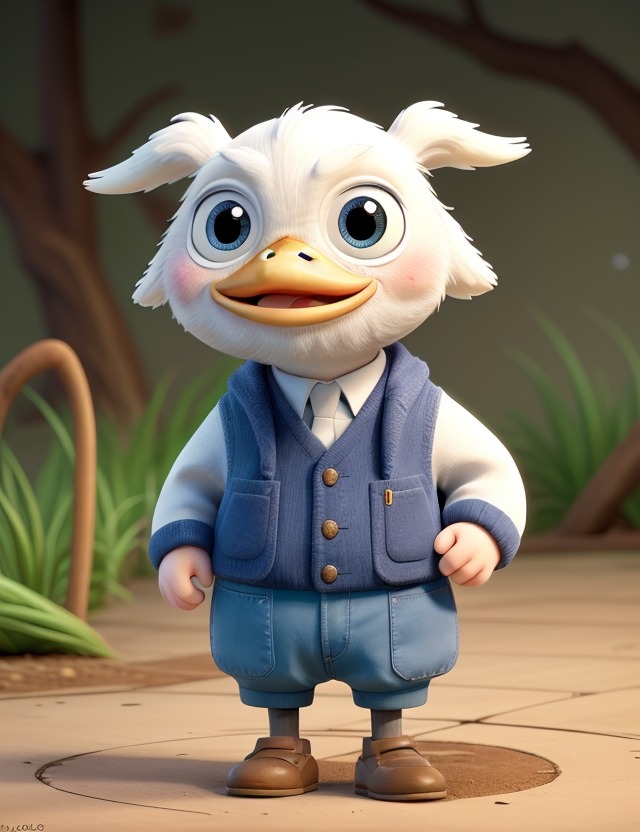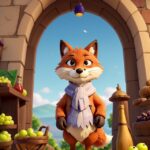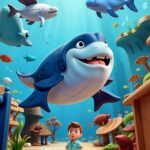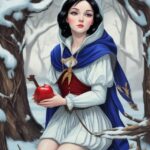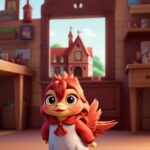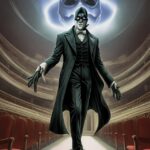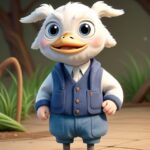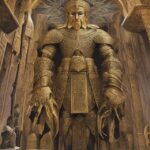Have you ever felt like the odd one out, the misfit among your peers? It’s a common experience that often leaves us questioning our worth and searching for acceptance. In Hans Christian Andersen’s timeless classic, “The Ugly Duckling,” this very theme takes center stage, captivating readers of all ages with its profound message of self-discovery and personal transformation.
Join us as we dive into the heartwarming story of a little duckling’s journey from rejection to acceptance, and explore the historical significance behind this beloved tale that has stood the test of time. Prepare to be captivated by Andersen’s enchanting narrative, and discover how this story continues to resonate with readers, young and old, across the globe. So, whether you’re familiar with this beloved fable or discovering it for the first time, get ready to be transported into a world of growth, acceptance, and the power of embracing one’s true self.
Ugly Duckling Original Short Story
Once upon a time, a mother duck sat on her nest waiting for her eggs to hatch. When they finally did, she was overjoyed to see her little ducklings. However, one of the eggs was much larger than the others and took longer to hatch. When it finally did, out came a baby bird that was much bigger and uglier than the others. The other ducklings made fun of him and refused to play with him. Feeling sad and alone, the ugly duckling left the farm and went out into the world.
As he traveled, he met many different animals who also made fun of him for being different. But eventually, he found a group of swans who accepted him for who he was. When he looked at his reflection in the water, he realized that he was no longer an ugly duckling, but a beautiful swan.
The Ugly Duckling Full Story Summary in English
Once upon a time, in a beautiful meadow surrounded by tall trees and shimmering ponds, a mother duck sat patiently on her nest. She was waiting for her eggs to hatch, hoping to look into the eyes of her precious ducklings. Finally, the day arrived, and one by one, the eggs cracked open to reveal fluffy little ducklings.
However, as the mother duck counted her babies, she noticed a hatchling that looked different from the rest. This little duckling was gray and big, with a long neck and clunky feet. He was ugly and didn’t fit in with his siblings. The other animals in the meadow laughed and whispered about the strange-looking duckling.
Feeling sad and out of place, the ugly duckling decided to leave his home and set off on a journey to find where he truly belonged. He traveled through meadows, forests, and rivers, encountering various animals along the way. But wherever he went, he was teased and mocked for his appearance.
One day, as the ugly duckling was wandering through a snowy landscape, he stumbled upon a cottage where a kind old lady lived. She took him in and provided him with warmth and comfort. The ugly duckling felt safe and loved for the first time in his life. But deep down, he still longed to find his true identity.
Spring arrived, and with it came the return of the birds. The ugly duckling watched as graceful swans landed in the nearby pond, their feathers shimmering in the sunlight. He was captivated by their beauty and elegance. However, he couldn’t help but feel a pang of sadness, knowing he could never be like them.
One day, as the swans swam near the cottage, they saw the ugly duckling and were amazed by his size and his unique appearance. They joyfully approached him and welcomed him into their group, much to his astonishment. The ugly duckling couldn’t believe it; he had finally found his place among the swans.
As the days passed, the ugly duckling transformed into a magnificent swan. His gray feathers turned into gleaming white, and he grew a graceful neck. The other swans admired his beauty and elegance, and he realized that his journey had led him to his true self. No longer did he feel ugly or out of place; he had finally found his home and his family.
The ugly duckling learned a valuable lesson about the importance of self-acceptance and embracing one’s differences. He understood that outer beauty does not define who we are inside. The swans taught him that true beauty comes from within and that everyone has their unique qualities that make them special.
With newfound confidence and a deep sense of belonging, the once ugly duckling lived happily ever after among the swans. He soared through the sky, gliding with grace and radiating beauty. The other animals in the meadow admired him and learned to celebrate their differences as well.
And so, the story of the ugly duckling teaches us that our true worth lies beyond what meets the eye. It reminds us to embrace ourselves and others as we are, for it is our differences that make us beautiful and unique. Just like the ugly duckling, we can all find our place in the world, where we can shine and be loved for exactly who we are.
The Ugly Duckling: Key Themes
“The Ugly Duckling” is a beloved children’s story written by Hans Christian Andersen. It tells the tale of a small, unattractive duckling that is rejected and mistreated by its peers due to its differences. However, as the story unfolds, the duckling goes through a transformative journey of self-discovery, eventually blossoming into a beautiful swan. Here are three key themes explored in “The Ugly Duckling”:
1. Acceptance and Belonging: One of the central themes of the story is the longing for acceptance and the desire to belong. The ugly duckling’s journey resonates with readers of all ages, as it reflects our innate need for recognition and understanding. From the very beginning, the duckling faces rejection and cruelty from other animals, which causes it to question its own worth and place in the world. This theme highlights the importance of embracing diversity, kindness, and inclusivity, as the duckling finally finds acceptance when it discovers its true identity as a swan.
2. Self-Discovery and Identity: Another key theme explored in the story is self-discovery and the journey towards self-acceptance. Throughout the narrative, the duckling grapples with feelings of inadequacy and struggles to find its place in the world. It constantly compares itself to others who appear more beautiful and successful, which causes immense suffering. However, as the ugly duckling matures, it starts to realize its own potential and unique beauty. This theme teaches readers that true happiness lies in accepting oneself and having the courage to embrace one’s own identity.
3. Transformation and Growth: “The Ugly Duckling” also emphasizes the idea of transformation and personal growth. The story showcases how adversity and challenges can lead to personal development and a positive transformation. As the duckling faces rejection, it endures suffering and hardship, which ultimately enables it to recognize its own strength and inner beauty. This theme teaches readers the importance of resilience, perseverance, and embracing change, as the ugly duckling’s transformation is not only physical but also emotional and psychological.
Overall, “The Ugly Duckling” explores important themes of acceptance, self-discovery, and transformation. Through the journey of the ugly duckling, readers are reminded of the significance of embracing diversity, finding one’s own identity, and growing through life’s challenges.
The Ugly Duckling: Characters
- The Ugly Duckling:
- Description: This poor little duckling is described as being awkward, misshapen, and quite ugly compared to his siblings. He is constantly bullied and feels like an outcast in the duck community.
- Role in the story: As the protagonist, the Ugly Duckling embarks on a journey to find his place in the world. He endures hardships and rejection but ultimately transforms into a beautiful swan.
- Physical description: Covered in gray, scruffy feathers, with an oversized body, long neck, and clumsy appearance.
- Funny data: The Ugly Duckling is often mistaken for other animals simply because of his unconventional looks, causing some humorous misunderstandings.
- Mother Duck:
- Description: Mother Duck is a loving and caring figure, with a gentle nature. She tries her best to protect and nurture all her eggs, including the Ugly Duckling.
- Role in the story: Mother Duck represents unconditional love and acceptance. She initially defends the Ugly Duckling, but due to societal pressure, she is unable to protect him completely.
- Physical description: A graceful and well-proportioned duck, with vibrant feathers and a warm, nurturing presence.
- Funny data: Mother Duck has a habit of gathering her ducklings under her wings, providing warmth and protection, often resulting in a comical sight of little heads poking out.
- The Farm Animals:
- Description: The farm animals are a quirky and lively bunch, consisting of chickens, geese, turkeys, and pigs. They all have distinct personalities and interact with the Ugly Duckling during his time on the farm.
- Role in the story: While initially hostile towards the Ugly Duckling, the farm animals play a crucial role in shaping his identity. They provide a contrast between acceptance and rejection, highlighting the importance of true friendship and empathy.
- Physical description: Each animal has its own unique physical characteristics, such as the chicken’s beady eyes, the turkey’s extravagant feathers, and the pig’s round and chubby figure.
- Funny data: The farm animals often engage in humorous banter and rivalries, creating entertaining scenes as they try to outsmart each other for food or attention.
- The Swans:
- Description: The swans represent elegance, grace, and beauty. They exude a sense of confidence and sophistication.
- Role in the story: The swans serve as a turning point for the Ugly Duckling. When the Ugly Duckling discovers that he is not a duckling but a beautiful swan, it is the swans who embrace him and help him realize his true potential.
- Physical description: The swans have snow-white feathers, slender necks, and a dignified presence that sets them apart.
- Funny data: Despite their elegance, the swans often engage in playful activities, gracefully gliding on the water or engaging in synchronized swimming, amusing both the Ugly Duckling and readers.
- The Reflection:
- Description: The reflection of the Ugly Duckling serves as a critical character in his journey towards acceptance and self-discovery.
- Role in the story: The reflection represents the Ugly Duckling’s internal struggle with self-identity, as he compares himself to others. It is through contemplating his reflection that he begins to question his own worth and eventually ends his journey of transformation.
- Physical description: The reflection is a mirror-like figure, with shimmering qualities that reveal the Ugly Duckling’s true inner beauty.
- Funny data: The reflection often mimics the Ugly Duckling’s gestures, eliciting comical and endearing expressions as he tries to understand his own physical appearance.
The Ugly Duckling: Symbols
1. The Ugly Duckling: The main symbol in the story is the ugly duckling itself. At the beginning of the book, the little duck is seen as different and unattractive compared to his siblings, symbolizing feelings of isolation, rejection, and low self-esteem. However, as the story progresses, the ugly duckling transforms into a beautiful swan, representing a metaphor for personal growth, self-acceptance, and the realization of one’s true potential. This symbol teaches us not to judge others based on their appearances and highlights the importance of self-belief and perseverance.
2. Mother Duck: The mother duck in the story represents a symbol of love, nurturing, and acceptance. Despite the ugly duckling’s differences, his mother loves and protects him, teaching important values such as unconditional love and acceptance. The mother duck’s character symbolizes the power of maternal instinct and serves as a reminder that love can conquer prejudice and discrimination.
3. Nature: Nature plays a vital symbol throughout the book, portraying renewal, transformation, and the natural order of life. The ugly duckling’s journey takes him through various stages of development, from being rejected by others to finding his rightful place in the world. This symbolizes the cyclical nature of life and emphasizes the beauty and diversity found in the natural world. The changing seasons and the transformation of the protagonist into a swan reflect the concept of personal growth and transformation found in nature. Additionally, the serene settings of ponds, forests, and meadows symbolize peace, harmony, and a return to one’s true nature.
Ugly Duckling Moral
The moral of the story “The Ugly Duckling” is that one should not judge a person by their outward appearance. The story narrates the life of a duckling who is ridiculed and mistreated by his peers because of his appearance. The duckling searches for a place where he will be accepted for who he is, but he cannot find that place with ducks, hens, or geese. He wishes to be beautiful like the swans he sees flying in the sky, yet he is too young to fly. By spring, he becomes fully grown and tries to join a flock of swans. The swans don’t tease him like others, but they treat him like one of them. The duckling is so surprised that such beautiful creatures would want to be with him. But then he sees his reflection in the water and sees that he too is a beautiful swan. He has finally found his home with the swans and is at peace from all the mocking and ridicule he has endured in the past.
This story teaches us many lessons. The most important lesson of all is that we shouldn’t discriminate people, judging by their physical appearance. The barnyard animals ridicule and mock the duckling because he doesn’t look like one of them. It is only because of this strange appearance that they treat him differently. The idea that we should never give up on following our passions and finding our place in society is also apparent in this story. When the duckling tries to fit in with the other barnyard animals, he gets a lot of advice from them on how to become one of them. But in the end, he follows his passion for swimming. And when the duckling joins the flock of swans, he doesn’t know how his reception will be. He is simply following his passion and his desire to find his place in society no matter what happens.
The Ugly Duckling: Culture Impact
The Ugly Duckling, a timeless children’s tale penned by renowned Danish author Hans Christian Andersen, has left an indelible mark on global culture throughout the years. First published in 1843, this heartwarming story has captured the imaginations of readers both young and old, transcending generations and borders.
Historically, this enchanting fable played a significant role in fostering a sense of empathy and inclusivity. During the 19th century, Europe was experiencing a wave of industrialization and urbanization, leading to a rapidly changing social fabric. The Ugly Duckling provided comfort during this transformative period by emphasizing the power of inner beauty and the potential for personal growth. Its message resonated deeply with individuals struggling to find their place in this evolving society.
The book’s cultural impact can be seen in various forms of entertainment throughout the years. Countless stage adaptations, puppet shows, and even ballets have graced theaters around the world, bringing the tale to life in captivating and imaginative ways. The Ugly Duckling has served as a source of inspiration for artists, musicians, and filmmakers, who have reimagined the story to reflect contemporary social issues and spread its timeless themes to new audiences.
One of the book’s most remarkable achievements is its ability to deliver profound lessons through lighthearted and endearing storytelling. By employing animal characters, Andersen skillfully masks societal critiques and delivers moral lessons with a touch of humor. The journey of the awkward little duckling resonates with individuals who have experienced feelings of inadequacy, rejection, or being misunderstood. The book’s enduring popularity lies in its ability to provide comfort and hope, reminding readers that they too can find their place and embrace their unique qualities.
The Ugly Duckling’s impact can also be observed in a broader sociocultural context. Its core message of acceptance and embracing diversity has played a vital role in shaping attitudes towards differences and encouraging tolerance. By challenging the superficial judgment of outward appearances, the story has become a symbol of inclusivity and a catalyst for fostering empathy and compassion within communities.
Moreover, The Ugly Duckling’s enduring legacy can be seen in its influence on contemporary children’s literature. Many authors and storytellers draw inspiration from this classic tale, creating narratives that encourage individuality, self-acceptance, and empathy among young readers. This influence has paved the way for a myriad of stories that celebrate diversity and challenge conventional beauty standards, empowering children to embrace their own uniqueness.
In conclusion, The Ugly Duckling, with its rich historical background, endearing storytelling, and enduring themes, has left an indelible mark on global culture. Through its impact on stage adaptations, artistic reinterpretations, and inspiring contemporary literature, Andersen’s beloved tale continues to captivate hearts, encourage empathy, and celebrate the beauty found within every individual.
FAQs
1. Who is the author of “The Ugly Duckling”?
“The Ugly Duckling” is a fairy tale that was written by Hans Christian Andersen.
2. What is the main theme of “The Ugly Duckling”?
The main theme of “The Ugly Duckling” is the importance of self-acceptance and the understanding that one’s true beauty lies within.
3. Can you provide a brief summary of “The Ugly Duckling”?
The story follows a little duckling who is ostracized and ridiculed for looking different from his siblings. Eventually, he discovers that he is not a duck but a beautiful swan, illustrating the idea that appearances can be deceiving.
4. Is there a moral lesson in “The Ugly Duckling”?
Yes, the story teaches us the valuable lesson that one should not judge others based on their outward appearance, but rather look for their true worth and potential.
5. Is “The Ugly Duckling” suitable for children of all ages?
Yes, “The Ugly Duckling” is a popular tale for children and is suitable for all ages, as it teaches important values like kindness, acceptance, and embracing individuality.
